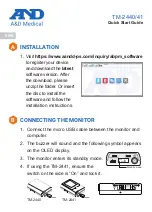
Dakota Ultrasonics
112
zero and produces only a load factor. Why are both options needed? In applications
where a small amount of load is applied to the fastener, thus producing very little
elongation, the regression option can potentially produce non-linear results. In cases
such as these, a vector may sometimes produce better results as the offset is set at
zero. It is recommended to use and compare both results, following a field
calibration, to determine which method is most suitable for the application and
producing the best results.
11.3 Performing a Field Calibration
This section outlines the necessary procedures to perform a field calibration to
determine a Load Factor and Offset (in the case of using regression). In the
calibration procedures below, three sample bolts will be used with three loads applied
to each bolt (1/3, 2/3, & max). This should be considered the minimum requirement
when performing a field calibration.
Creating a Group Name to Document Field Calibration Data
Applied
Load
(Measured
by Tensile
Machine)
Elongation (in time as measured by MiniMax)
At low loads, vector
can be more accurate
Vector
Regression
Summary of Contents for MAX II
Page 2: ......
Page 7: ......
Page 8: ......
Page 54: ...Dakota Ultrasonics 46 Figure 6 Reflection in a bending bolt ...
Page 215: ......
















































